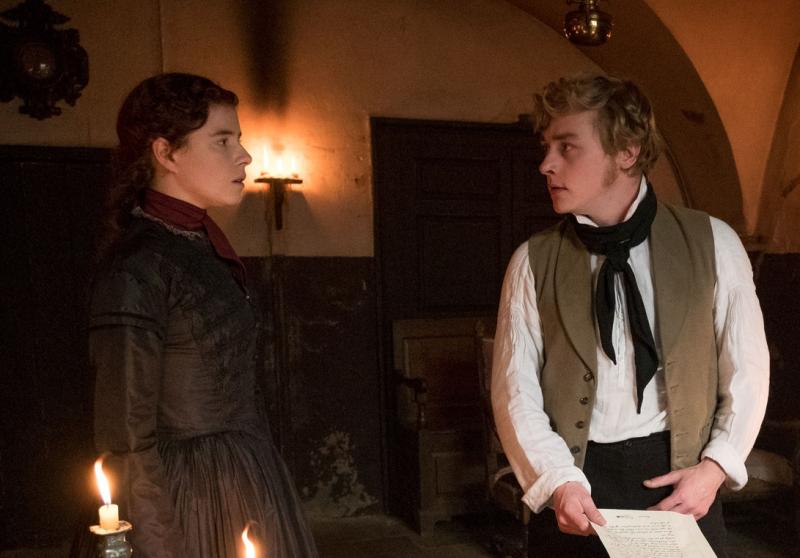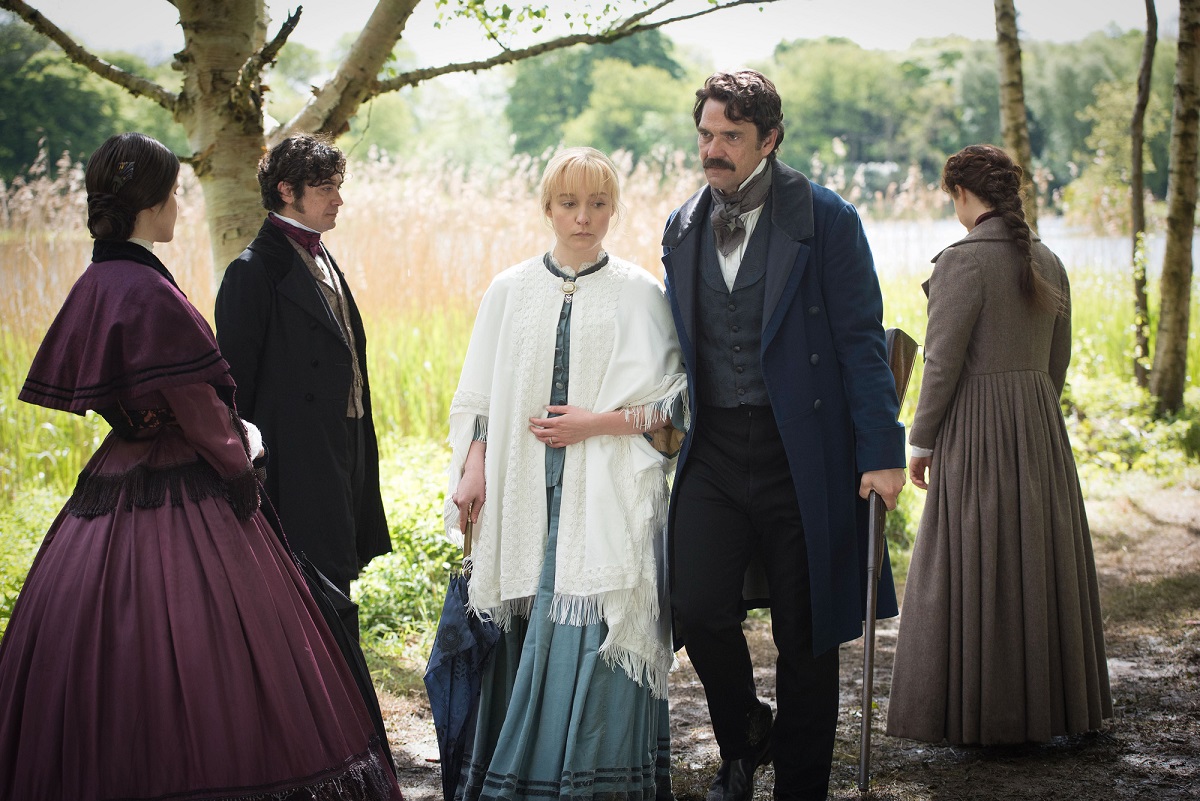The Woman in White, Series Finale, BBC One review - good-looking, but flat | reviews, news & interviews
The Woman in White, Series Finale, BBC One review - good-looking, but flat
The Woman in White, Series Finale, BBC One review - good-looking, but flat
Frisson lost in Wilkie Collins adaptation low on individuality, drama

Much has been made of this adaptation of The Woman in White having an especial relevance for our times.
In fact, it took some rather easy ways out, making for a sense that the glorious landscapes of Northern Ireland that provided the backdrops weren’t the only thing chosen for their photogenic quality. Collins makes no bones about Walter Hartright’s first impression of his novel’s marvellous heroine, Marian Halcombe: “The lady is ugly!” Which you certainly couldn’t say of Buckley, who sometimes (rather unsettlingly) seemed to be channelling Jenny Agutter from The Railway Children, with the impression that hockey sticks, if not quite jolly, certainly weren’t morose. (That very final scene, in which Buckley seemed to be gallivanting in the desert, was an extremely strange way to bow out, but at least it gave a sense of some unexpected depths.) Collins would hardly have recognised his great villain, either: Count Fosco, too, was much changed, “odious corpulence” not being a charge you could level at the comely, however louche Riccardo Scamarcio (the small animals, white mice and all, that are no less a part of Fosco went by the wayside, too). Admittedly, nothing was lost in the chemistry of his interactions with Marian – how he manages to win her “half-willing, half-unwilling liking” says so much about sexual fascination, feelings especially radical for the Victorian era – but it was a different balance of forces entirely (pictured below: Jessie Buckley, Riccardo Scamarcio). It also gave an unexpected intonation to the scene between Dougray Scott as Sir Percival Glyde and his friend, who was conversing from his bath (“You reveal yours, I reveal mine”: secrets, of course).
Collins would hardly have recognised his great villain, either: Count Fosco, too, was much changed, “odious corpulence” not being a charge you could level at the comely, however louche Riccardo Scamarcio (the small animals, white mice and all, that are no less a part of Fosco went by the wayside, too). Admittedly, nothing was lost in the chemistry of his interactions with Marian – how he manages to win her “half-willing, half-unwilling liking” says so much about sexual fascination, feelings especially radical for the Victorian era – but it was a different balance of forces entirely (pictured below: Jessie Buckley, Riccardo Scamarcio). It also gave an unexpected intonation to the scene between Dougray Scott as Sir Percival Glyde and his friend, who was conversing from his bath (“You reveal yours, I reveal mine”: secrets, of course).
It wasn’t only Fosco who was unconscionably thin here. The original novel, with its episodic structure and different narratorial voices grappling for control, was always going to be problematic for adaptation purists, but this version felt flat. Yes, once you worked out what was going on, there was a degree of ongoing investigative interest from Art Malik as the Dickensianly-named scrivener, Erasmus Nash (his added context story as sentimental a piece of guff as that writer would never have resorted to). But it was just too lugubrious to attain much drive, the exception that proved that rule being the briefest appearance of Mrs Hartright (Cathy Belton, stepping in from Mrs Gaskell?), with her own urgent questions about her son. How it made you root for someone who disrupted proceedings a bit!
 Director Carl Tibbetts and his collaborators created it with all the love and care characteristic of the BBC’s Sunday night period slot, but how clunky it sometimes felt (yes, melodrama can be a clunky genre…). The glowing, golden-boy charm of Ben Hardy as Walter Hartright just didn’t cut the mustard – his distress in one scene was principally suggested by a clumsy disruption of make-up, which otherwise only seemed to change with the sprouting of sideburns. No sense of urgent engagement between him and Buckley’s Marian came close to transfixing.
Director Carl Tibbetts and his collaborators created it with all the love and care characteristic of the BBC’s Sunday night period slot, but how clunky it sometimes felt (yes, melodrama can be a clunky genre…). The glowing, golden-boy charm of Ben Hardy as Walter Hartright just didn’t cut the mustard – his distress in one scene was principally suggested by a clumsy disruption of make-up, which otherwise only seemed to change with the sprouting of sideburns. No sense of urgent engagement between him and Buckley’s Marian came close to transfixing.
Indeed, there were times when the principle imperative behind some of their dialogue felt like it was to impart the next necessary piece of plot development, preferably in words of no more than one syllable. At their very first meeting over the breakfast table, Buckley warned him to avoid the ham, advice that this production, solid but no more, failed to heed. The ever-changing colour in Jon Opstad’s score had as much character as anything else here, and often rather more nuance than the protagonists.
rating
Explore topics
Share this article
The future of Arts Journalism
You can stop theartsdesk.com closing!
We urgently need financing to survive. Our fundraising drive has thus far raised £49,000 but we need to reach £100,000 or we will be forced to close. Please contribute here: https://gofund.me/c3f6033d
And if you can forward this information to anyone who might assist, we’d be grateful.

Subscribe to theartsdesk.com
Thank you for continuing to read our work on theartsdesk.com. For unlimited access to every article in its entirety, including our archive of more than 15,000 pieces, we're asking for £5 per month or £40 per year. We feel it's a very good deal, and hope you do too.
To take a subscription now simply click here.
And if you're looking for that extra gift for a friend or family member, why not treat them to a theartsdesk.com gift subscription?
more TV
 The Perfect Neighbor, Netflix review - Florida found-footage documentary is a harrowing watch
Sundance winner chronicles a death that should have been prevented
The Perfect Neighbor, Netflix review - Florida found-footage documentary is a harrowing watch
Sundance winner chronicles a death that should have been prevented
 Murder Before Evensong, Acorn TV review - death comes to the picturesque village of Champton
The Rev Richard Coles's sleuthing cleric hits the screen
Murder Before Evensong, Acorn TV review - death comes to the picturesque village of Champton
The Rev Richard Coles's sleuthing cleric hits the screen
 Black Rabbit, Netflix review - grime and punishment in New York City
Jude Law and Jason Bateman tread the thin line between love and hate
Black Rabbit, Netflix review - grime and punishment in New York City
Jude Law and Jason Bateman tread the thin line between love and hate
 The Hack, ITV review - plodding anatomy of twin UK scandals
Jack Thorne's skill can't disguise the bagginess of his double-headed material
The Hack, ITV review - plodding anatomy of twin UK scandals
Jack Thorne's skill can't disguise the bagginess of his double-headed material
 Slow Horses, Series 5, Apple TV+ review - terror, trauma and impeccable comic timing
Jackson Lamb's band of MI5 misfits continues to fascinate and amuse
Slow Horses, Series 5, Apple TV+ review - terror, trauma and impeccable comic timing
Jackson Lamb's band of MI5 misfits continues to fascinate and amuse
 Coldwater, ITV1 review - horror and black comedy in the Highlands
Superb cast lights up David Ireland's cunning thriller
Coldwater, ITV1 review - horror and black comedy in the Highlands
Superb cast lights up David Ireland's cunning thriller
 Blu-ray: The Sweeney - Series One
Influential and entertaining 1970s police drama, handsomely restored
Blu-ray: The Sweeney - Series One
Influential and entertaining 1970s police drama, handsomely restored
 I Fought the Law, ITVX review - how an 800-year-old law was challenged and changed
Sheridan Smith's raw performance dominates ITV's new docudrama about injustice
I Fought the Law, ITVX review - how an 800-year-old law was challenged and changed
Sheridan Smith's raw performance dominates ITV's new docudrama about injustice
 The Paper, Sky Max review - a spinoff of the US Office worth waiting 20 years for
Perfectly judged recycling of the original's key elements, with a star turn at its heart
The Paper, Sky Max review - a spinoff of the US Office worth waiting 20 years for
Perfectly judged recycling of the original's key elements, with a star turn at its heart
 The Guest, BBC One review - be careful what you wish for
A terrific Eve Myles stars in addictive Welsh mystery
The Guest, BBC One review - be careful what you wish for
A terrific Eve Myles stars in addictive Welsh mystery
 theartsdesk Q&A: Suranne Jones on 'Hostage', power pants and politics
The star and producer talks about taking on the role of Prime Minister, wearing high heels and living in the public eye
theartsdesk Q&A: Suranne Jones on 'Hostage', power pants and politics
The star and producer talks about taking on the role of Prime Minister, wearing high heels and living in the public eye
 King & Conqueror, BBC One review - not many kicks in 1066
Turgid medieval drama leaves viewers in the dark
King & Conqueror, BBC One review - not many kicks in 1066
Turgid medieval drama leaves viewers in the dark

Add comment